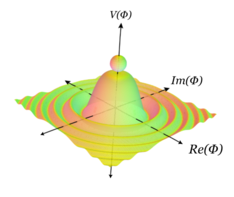
Back كسر التناظر Arabic Simetria trencada Catalan Symmetri-brud Danish Symmetriebrechung German Simetría rota Spanish Brisure de symétrie French Briseadh siméadrachta Irish 対称性の破れ Japanese Нарушување на симетријата Macedonian Quebra de simetria Portuguese
This article needs additional citations for verification. (October 2021) |

In physics, symmetry breaking is a phenomenon where a disordered but symmetric state collapses into an ordered, but less symmetric state.[1] This collapse is often one of many possible bifurcations that a particle can take as it approaches a lower energy state. Due to the many possibilities, an observer may assume the result of the collapse to be arbitrary. This phenomenon is fundamental to quantum field theory (QFT), and further, contemporary understandings of physics.[2] Specifically, it plays a central role in the Glashow–Weinberg–Salam model which forms part of the Standard model modelling the electroweak sector.


In an infinite system (Minkowski spacetime) symmetry breaking occurs, however in a finite system (that is, any real super-condensed system), the system is less predictable, but in many cases quantum tunneling occurs.[2][3] Symmetry breaking and tunneling relate through the collapse of a particle into non-symmetric state as it seeks a lower energy.[4]
Symmetry breaking can be distinguished into two types, explicit and spontaneous. They are characterized by whether the equations of motion fail to be invariant, or the ground state fails to be invariant.
- ^ Heylighen, Francis (2023). "Entanglement, Symmetry Breaking and Collapse: Correspondences Between Quantum and Self-Organizing Dynamics". Foundations of Science. 28. Brussels, Belgium: 85–107. doi:10.1007/s10699-021-09780-7. S2CID 4568832 – via SpringerLink.
- ^ a b Gross, David J. (1996-12-10). "The role of symmetry in fundamental physics". PNAS. 93 (25): 14256–14259. doi:10.1073/pnas.93.25.14256. PMC 34470. PMID 11607718.
- ^ Ohira, Ryutaro; Mukaiyama, Takashi; Toyoda, Kenji (2020-02-01). "Breaking rotational symmetry in a trapped-ion quantum tunneling rotor". Physical Review A. 101 (2). American Physical Society: 022106. arXiv:1907.07404. Bibcode:2020PhRvA.101b2106O. doi:10.1103/PhysRevA.101.022106.
- ^ Castellani, Elena; Teh, Nicholas; Brading, Katherine (2017-12-14). Edward, Zalta (ed.). "Symmetry and symmetry breaking". Stanford Encyclopedia of Philosophy (Fall 2021 ed.). Metaphysics Research Lab, Stanford University.
